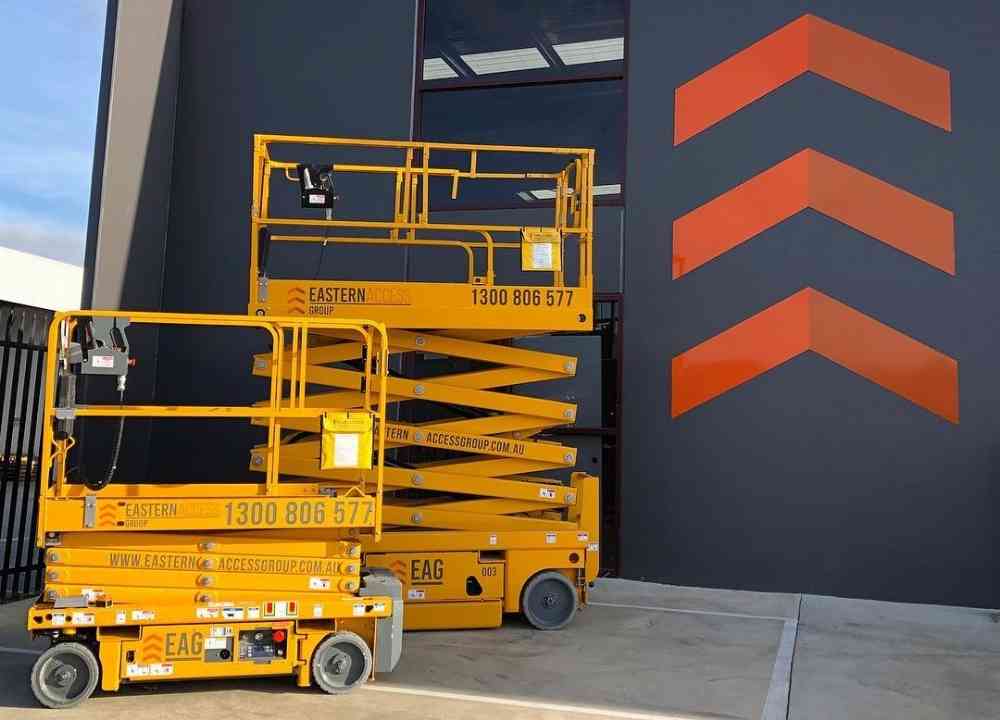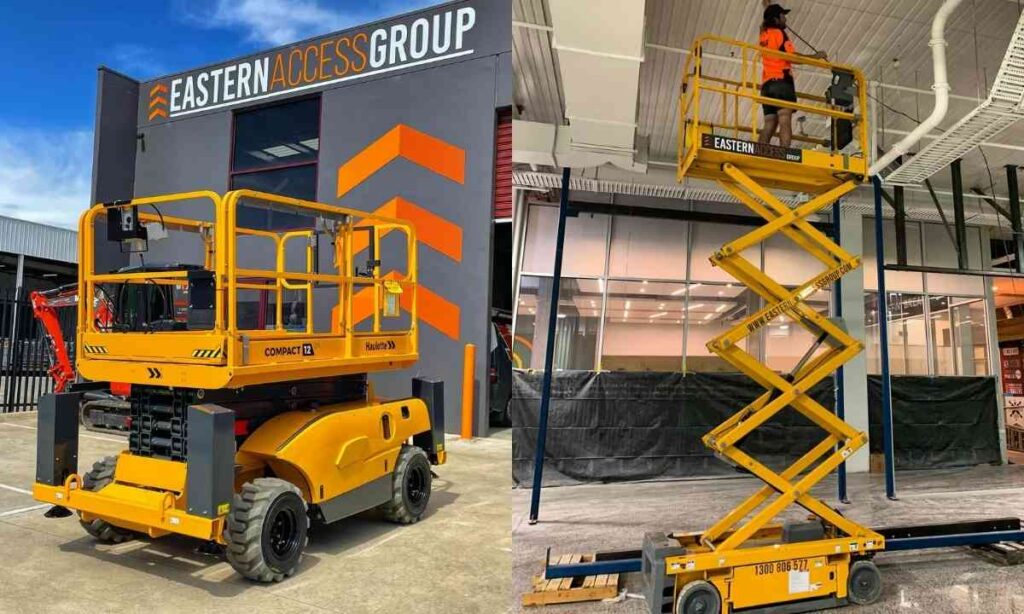The A-Z of Rough Terrain Scissor Lifts
It should come as no surprise that all terrain scissor lifts are an excellent choice if your jobs are outside where the terrain isn’t always flat. They’re well-equipped to withstand even the worst weather and are available in fuel types, including diesel, gas, propane, and duo fuel. Rough terrain lifts, which may reach heights up to 50 feet, can be extremely useful in handling even the most challenging building projects.
Table of Contents
Rough terrain lifts in Australia are designed to handle rough, muddy, or uneven terrains and are powered by gas or diesel. They can reach a height of more than 50 feet and offer a bigger work platform than electric scissor lifts. If you need to work on steep or uneven terrain, a 4WD scissor lift, which is available in numerous rough-terrain scissor and electric scissor lifts, is the ideal alternative. You should think about the ground clearance. If you need to travel over rubble or through exceptionally tough terrain, a vehicle with more ground clearance is recommended.

What is a Rough Terrain Scissor Lift?
The function of these machines is to elevate people and objects off the uneven ground. Consider hiring a rough terrain scissor lift for outside jobs or on surfaces that aren’t perfectly flat and level. These machines are built to perform in difficult environments and increase production by providing excellent positive traction, speed, and grade ability. They usually have larger work platforms, more weight capacity, and more vertical reach.
The scissor lifts offer excellent terrain capabilities thanks to their robust 4-wheel drive. An all-terrain scissor lift can readily handle heavy operations because of its broad platform working surfaces and great lifting capacity. There is also a bi-energy power source option, which provides clean and silent battery power for maximum job site versatility.
Rough terrain scissor lifts are also created specifically for use in the outdoors. They have a large carrying capacity, heavy-duty tyres, and additional safety features. This makes them perfect not only for projects that take place on uneven ground or slopes, as well as tasks that take place in severe weather. All-terrain scissor lifts have a maximum elevation of 50 feet and a maximum breadth of 10 feet. Diesel, gas, liquid propane, or dual fuel are used to power the equipment.
What is Considered Rough Terrain?
Rough terrain scissor lifts are useful in situations, primarily in outdoor settings with uneven or sloping terrain. Before hiring a piece of equipment, make sure you know what kind of terrain you’re working on and how steep the slope is. Gradeability is a measurement used by rough terrain scissor lifts. Rough terrain lifts are outfitted with high-performance tyres and 4WD, giving them a steeper gradient.
These scissor lifts are safe and simple to use because they have a four-wheel drive (4WD). Construction, painting, cleaning, overhead lighting, and plumbing are just a few sectors that use it.
What Are Their Main Features?
All-terrain scissor lifts are tough, construction-oriented machines with strong traction control, making them ideal for boosting production at tough outdoor job sites.
The increased power is a common attribute (provided by internal combustion engines, variations can be diesel, petrol, gas, or combinations). This is necessary to deal with the larger weights and steeper gradients of 18 to 22 degrees that are common with a 4WD terrain scissor lift. Four hydraulic stabilizers with automatic leveling, non-marking foam-filled tyres, even axle weight distribution, positive traction control, rear-wheel braking, and an “oscillating axle” are also used to help keep all four wheels on the ground when traveling over rough terrain.
Rough Terrain Scissor Lift Benefits
If you rent a rough terrain scissor lift for your job, you’ll get four-wheel drive, positive traction control, and reinforced tyres. In difficult outdoor conditions, these machines provide secure and stable work platforms. Rough terrain scissor lifts give more workspace for operators and have a larger weight capacity than inside scissor lifts.
Rough terrain scissor lift rentals give solutions for difficult applications, outstanding value, and consistent performance. The rental fleet includes several high-quality machines from prominent companies, whether you’re working in forestry, mining, or construction. They ensure that reliable performance is delivered under all conditions while increasing productivity and reducing downtime.
Specialty Uses of Rough Terrain Scissor Lifts
Because of their versatility and heavy-duty capabilities, many customers prefer rough terrain scissor lift rentals over other options. Rough terrain lifts can be utilised indoors but are intended for difficult terrain and weather and construction-related duties. Because all terrain scissor lifts may operate on slopes, they have a grade ability range of 0 to 50%, depending on the model.
What Should You Consider Before Renting a Rough Terrain Scissor Lift?
Consider the terrain and environment of your project — if you are working on uneven ground and weather conditions vary, renting an all-terrain lift can benefit your productivity levels.
Consider your project’s terrain and environment: if you’re working on uneven ground or in varying weather conditions, hiring an all-terrain lift can help you get more done. These vehicles have higher ground clearance, rougher tyres, and two or four-wheel drive options. It makes them suitable for use in dirt, hills, and gravel outdoors. They come in LPG or diesel versions and can support platform heights of up to 50 feet and loads of up 2,250 pounds. Outriggers are included on some units to improve stability on slick surfaces. It ensures that you have enough power and space for many employees and tools on the same units.
Top 3 Best Rough Terrain Scissor Lift Brands in Australia
1. JLG
Their diesel terrain scissor lift provides increased workspace and lifting capability, as well as an extraordinary ability to turn and operate on uneven terrain, making maneuvering a breeze. The JLG is one of the industry’s greatest on-the-job performance terrain machines, having the ability to run for twice as long with double the duty cycles of other electric scissor lifts on the market.
2. Skyjack
Skyjack is proud to provide excellent engineered diesel terrain scissor lifts that are primed and ready to take on any rough terrain height access project you may have. Their no-fuss machines are straightforward and dependable, allowing businesses to get the most out of them. Their terrain scissor lift has a spacious work platform, can be driven at full height, has selectable speeds, and has solid rubber tyres.
3. Snorkel
Use their diesel terrain scissor lift when the going gets tough. Large work platforms, a bi-energy power source, solid safety rails, and low weight make it easy to maneuver around your job site and adapt to any condition.
Safety Protocols for Rough Terrain Scissor Lifts
How to Safely Use a Rough Terrain Scissor Lift
Long before anyone steps foot on the terrain scissor lift, the majority of the effort that goes into making sure you and your crew are safe takes place. Safety preparedness for terrain scissor lifts is divided into four categories.
1. Environment
A terrain scissor lift can’t be used safely unless the surrounding area is secure. Prepare for the job ahead of time by assessing the job site and identifying potential risks, such as adjacent power lines or uneven ground. If the physical elements of your worksite prevent you from safely positioning or stabilizing your terrain scissor lift, you may need to make adjustments with the site manager.
2. Equipment Maintenance
It’s hard to create a safe work environment unless all of your equipment is properly and consistently maintained, no matter how cautious you are while operating a rough terrain scissor lift. If you own a scissor lift, make sure you follow the manufacturer’s recommended upkeep regimen. Before signing a rental agreement for a scissor lift, make sure you rent from a trustworthy vendor and enquire about their equipment repair routine.
You should test and inspect the controls of the terrain scissor lift before each use. Though the entire unit should be inspected regularly, testing the guardrail and brakes is especially vital to avoid sudden failure during a job.
3. Protective Measures
A scissor lift has an emergency stop button that turns off all functions immediately in an emergency. However, it’s critical to test this and any other emergency measures frequently to ensure that they’re working.
4. Training
Though no formal certification is required to operate a scissor lift, Safe Work Australia regulations require businesses to provide workers with training and the necessary personal protective equipment before they conduct work with one. Providing regular opportunities to brush up on fundamental training and go on the platform utilising the three points of contact approach are excellent ways to guarantee your entire team remains safe on and around the terrain scissor lift.
Scissor Lift Stabilization for Safe Use
Poor stability is one of the most dangerous and common causes of preventable scissor lift accidents. If the scissor lift isn’t secured properly, it can topple over, inflicting damage to the equipment and crew.
Here are some guidelines to follow to keep your terrain scissor lift from tipping over.
- If you’re working on a project that involves rocky terrain, make sure you use a scissor lift designed for that environment.
- Before relocating the equipment, make sure the work platform is completely lowered.
- Work only when the weather is suitable—most outdoor-rated scissor lifts are only certified for usage in wind speeds of less than 28 mph.
Terrain scissor lifts can also collapse on rare occasions, hurting individuals on and near the equipment. To avoid this, take the following steps.
- Be sure it has failsafe features before using your machinery
- Never exceed the manufacturer’s recommended weight limit.
- Other equipment should never be used to raise the work platform.
How to Safely Position a Terrain Scissor Lift
When it comes to reducing mishaps, where and how you place your terrain scissor lift for work can make a big difference. Crew members are at risk of being crushed or electrocuted when terrain scissor lifts are poorly positioned, so personnel must be instructed on how to avoid placement incidents.
When moving the scissor lift, exercise caution to avoid crushing occurrences. Make sure the area around the scissor lift is clear of people, and be wary of moving cars and stationary objects that may be in the way. If your workplace is congested, designate someone to conduct traffic control to avoid accidents.
If you’re working on a project that involves or is near a power source, keep a safe distance away from it to avoid electric damage. Always avoid direct contact with power lines, but keep in mind that even if neither the equipment nor the worker is directly touching the power source, electricity can arc from the power lines to the equipment or the worker. Before starting a project always, always check the manufacturer’s handbook for a list of safe distances that vary depending on the voltage of the source. Finally, if the project necessitates the use of an electrical source, ensure that all workers have received electrical training.
7 Tips for Operating a Scissor Lift Safely
There is a level of risk associated when using any equipment or operating at heights. It is critical to prioritize safety and adhere to procedures to ensure the equipment’s safe operation.
- Always know where and how to use the lift’s emergency stop and lowering mechanism.
- Never operate a lift alone.
- Always use a safety harness and other personal protective equipment (PPE).
- While working on a high platform, keep all tools secure.
- Before operating a terrain scissor lift, always inspect the task location, particularly the terrain on which the base will be situated and the height at which the operator will be working. Look for the branches, exposed cables, rafters, and other hazards.
- If you don’t know how to operate a terrain scissor lift, get proper training first.
- Never try to move an extended terrain scissor lift with another person on it.
Conclusion
You might choose to rent or buy a terrain scissor lift depending on the nature of your business and how frequently you use one. If you decide to hire a scissor lift, you should be aware of the various variables to consider. You must first determine the type of equipment to purchase, select a reliable organization to operate, comprehend your terrain, and evaluate the lift’s condition to ensure that it is in good working order.

